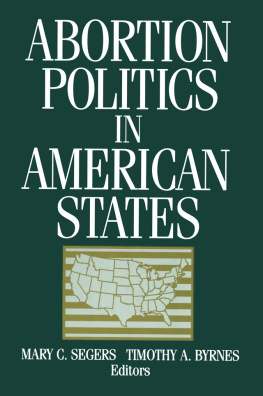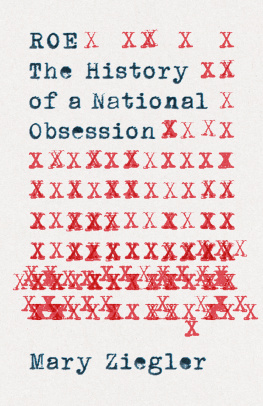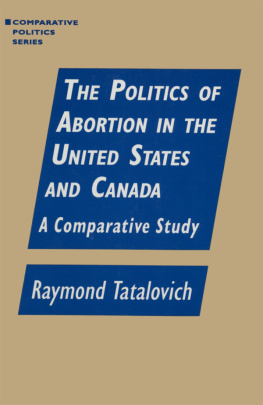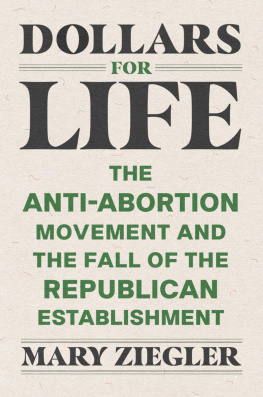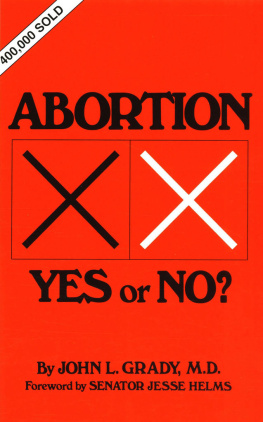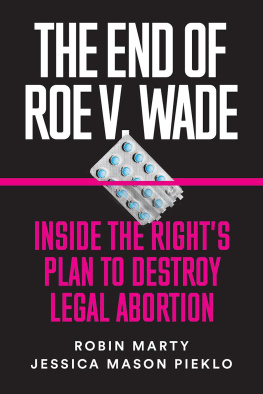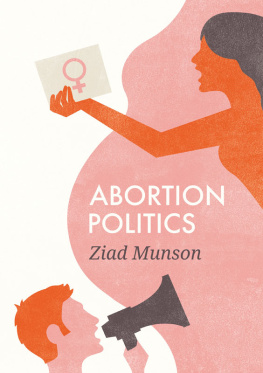ABORTION POLITICS IN AMERICAN STATES
Abortion Politics in American States
Mary C. Segers Timothy A. Byrnes
Editors
First published 1995 by M.E. Sharpe
Published 2015 by Routledge
2 Park Square, Milton Park, Abingdon, Oxon OX14 4RN
711 Third Avenue, New York, NY 10017, USA
Routledge is an imprint of the Taylor & Francis Group, an informa business
Copyright 1995 Taylor & Francis. All rights reserved.
No part of this book may be reprinted or reproduced or utilised in any form or by any electronic, mechanical, or other means, now known or hereafter invented, including photocopying and recording, or in any information storage or retrieval system, without permission in writing from the publishers.
Notices
No responsibility is assumed by the publisher for any injury and/or damage to persons or property as a matter of products liability, negligence or otherwise, or from any use of operation of any methods, products, instructions or ideas contained in the material herein.
Practitioners and researchers must always rely on their own experience and knowledge in evaluating and using any information, methods, compounds, or experiments described herein. In using such information or methods they should be mindful of their own safety and the safety of others, including parties for whom they have a professional responsibility.
Product or corporate names may be trademarks or registered trademarks, and are used only for identification and explanation without intent to infringe.
Library of Congress Cataloging-in-Publication Data
Abortion politics in American states / editors, Mary C. Segers and
Timothy A. Byrnes.
p. cm.
Includes bibliographical references and index.
ISBN 1563244497. ISBN 1563244500
1. AbortionPolitical aspectsUnited StatesStates.
2. AbortionGovernment policyUnited StatesStates.
I. Segers, Mary C. II. Byrnes, Timothy A., 1958
HQ767.5.U5A569 1995
363.4'6dc20
9427735
CIP
ISBN 13: 9781563244506 (pbk)
ISBN 13: 9781563244490 (hbk)
Contents
Mary C. Segers and Timothy A. Byrnes |
Pennsylvania: The Impact of Party Organization and
Religious Lobbying
Rosemary Nossiff |
Glen A. Halva-Neubauer |
Eliza Newlin Carney |
Christine L. Day |
Daniel J. ONeil |
Ruth Ann Strickland |
Patricia Bayer Richard |
Mary T. Hanna |
Michael A. Russo |
MaryAnne Borrelli |
Beyond Compromise: Casey, Common Ground, and the
Pro-Life Movement
James R. Kelly |
Mary C. Segers |
Timothy A. Byrnes |
Putting together a book such as this one is a little like participating in a nationwide seminar conducted by phone, fax, and e-mail. As editors, we wanted to produce a volume that would capture the vitality and diversity of state-level abortion politics in the United States, and we felt the best way to do so was to commission a series of case studies from a representative sample of states. From that beginning we embarked on a process of conversation and argumentation that resulted in Abortion Politics in American States.
This is not, then, a collection of readings; we did not approach a publisher with a packet of articles and papers that we had found elsewhere. Instead, this is a collaborative volume, an original work by thirteen contributors. All but two of the chapters were written because we expressly asked the authors to do so. None has been published previously. We set out a number of themes we wished the contributors to address and a number of variables we wished them to assess. Then the contributors applied those themes and variables to the complex, particular circumstances of their particular states. The result is a series of studies that we hope comprises a coherent and convincing whole.
We wish to thank Michael Weber of M. E. Sharpe for his initial support of this project and for his patience and guidance as it came to fruition. We also wish to acknowledge Thomas O'Hara for his help and his understanding and Dolores M. Byrnes for indexing the book.
Above all, we want to thank our contributors for making the process by which this book was produced so stimulating and, perhaps as important, so efficient. Over many conversations and exchanges of letters with them we have learned a tremendous amount about the states included in this volume and, of course, about the politics of abortion in the United States. We have also learned about the merits of collaboration and the value of collegiality. We sincerely hope that our work together has been as rewarding for them as it has been for us.
Mary C. Segers
Timothy A. Byrnes
MARY C. SEGERS AND TIMOTHY A. BYRNES
This is a book about the diversity and complexity of abortion politics in America in the 1990s and beyond. During the past thirty-five years, the issue of abortion has, at one time or another, confronted officials at every level of American governmentfrom the White House, Congress, and the Supreme Court to governors, state legislatures, state courts, county boards, and county executives. Even at the local level, school boards have had heated debates over the place of abortion in sex education curricula, zoning boards have considered whether an abortion clinic should be allowed to operate in a community, and police and municipal courts have had to cope with clinic protests and clinic violence. Few issues in American politics have so intensely engaged citizens and public officials at all levels of the American political system.
To be sure, the abortion issue has not confronted officials at all levels simultaneously. The institutional venue for abortion policy has shifted in response to Supreme Court decisions clarifying aspects of abortion in federal law. It is the shifting character of American abortion law that is of deepest interest today to scholars of abortion politics and political scientists who specialize in state politics. After all, abortion was originally a subject of state jurisdiction within the American federal system, a matter of marriage and family law within each state's legal system. The Supreme Court's decision in Roe v. Wade changed this and made abortion a matter of both state and federal law. Thus, both historically and currently, the fifty states have been central players in the law and politics of abortion in the United States.
This introductory chapter provides a brief historical overview of shifts and stages in the abortion controversy in the United States. Except for the first category, these stages are denoted by landmark cases that shifted the primary focus of abortion politics from one level of American government to another. Such stages include (1) the pre- Roe period (18001973); (2) from Roe to Webster (197389); (3) from Webster to Casey (198992); (4) Casey and beyond (1992 to the present). Basically, we argue that while abortion was an issue of state law and politics before 1973, the Supreme Court's decision in Roe v. Wade federalized abortion and made it a matter of state and federal policy. Although states responded in various ways to the Supreme Court's decision and some states continued to enact anti-abortion laws, Roe shifted the primary focus of abortion politics to the national level and to activities of the three branches of the federal government. Sixteen years later, a combination of changes at both state and national levels of government led to the Court's decision in Webster v. Reproductive Health Services, which refederalized abortion. In allowing state governments greater leeway to regulate abortion, Webster shifted the primary political emphasis once again back to the level of state politics. As a result of Webster and of the Court's 1992 ruling in Planned Parenthood of Southeastern Pennsylvania v. Casey , the abortion struggle continues to be waged fiercely at both national and state levels, a situation that will prevail for the foreseeable future.


